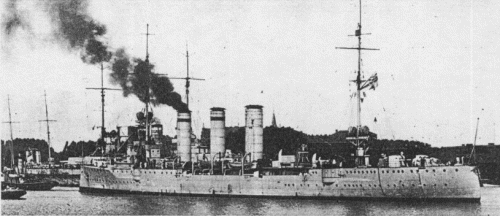

Kolberg 1913
| Name | No | Yard No | Builder | Laid down | Launched | Comp | Fate |
| Kolberg | 814 | Schichau, Danzig | 1908 | 14.11.1908 | 21.6.1910 | discarded 11.1919, to France (Colmar) | |
| Mainz | 288 | Vulcan, Stettin | 1907 | 23.1.1909 | 1.10.1909 | sunk 28.8.1914 | |
| Cöln | 141 | Germaniawerft, Kiel | 1908 | 5.6.1909 | 16.6.1911 | sunk 28.8.1914 | |
| Augsburg | 34 | KW Kiel | 1908 | 10.7.1909 | 1.10.1910 | test ship till 1912, TS 1912-1914, discarded 11.1919 |
|
Displacement normal, t |
4362 |
|
Displacement full, t |
Kolberg: 4915 Mainz: 4889 Cöln: 4864 Augsburg: 4882 |
|
Length, m |
130.5 oa 130.0 wl |
|
Breadth, m |
14.0 |
|
Draught, m |
Kolberg: 5.58 deep load Mainz: 5.60 deep load Cöln: 5.73 deep load Augsburg: 5.45 deep load |
|
No of shafts |
Kolberg, Augsburg: 4 Mainz, Cöln: 2 |
|
Machinery |
Kolberg: 4 Melms & Pfenniger steam turbines, 15 Marine boilers Mainz: 2 AEG-Curtiss steam turbines, 15 Marine boilers Cöln: 2 Germania steam turbines, 15 Marine boilers Augsburg: 4 Parsons steam turbines, 15 Marine boilers |
|
Power, h. p. |
Kolberg, Augsburg: 19000 Cöln, Mainz: 20200 |
|
Max speed, kts |
Kolberg, Augsburg: 25.5 Mainz, Cöln: 26 |
|
Fuel, t |
Kolberg: coal 970 Mainz: 1010 Cöln: 960 Augsburg: 940 |
|
Endurance, nm(kts) |
Kolberg: 3250(14) Mainz: 3630(14) Cöln, Augsburg: 3500(14) |
|
Armour, mm |
steel / Krupp steel - deck: 40 - 20, slopes: 80 - 50, glacises: 100, CT: 100, shields: 50 |
|
Armament |
12 x 1 - 105/42 SK L/45 C/06, 4 x 1 - 52/52 SK L/55 C/03, 2 - 450 TT (beam), 100 mines |
|
Complement |
367 |
Project history: Belonging to the 1906-7 programme these four cruisers marked an important step in the steady development of German light cruisers. Displacement rose about 20 per cent and speed by about 1.5kts compared with the previous Dresden class. Speed was bought by a simple increase in displacement to allow for heavier machinery and all four were equipped with competitive turbine systems: Kolberg Melms-Pfenninger, Mainz AEG-Curtiss, Coin Gerraania, Augsburg Parsons turbines. Maximum coal capacity varied.
Ship protection: 40mm protective deck with 80mm slopes protected machinery, outside machine spaces deck had turtleback form with 20mm flat and 50mm slopes. Engines had 100mm glacises. CT had 100mm sides and 20mm roof, guns had 50mm shields.
Modernizations: 1917, Kolberg, Augsburg: - 12 x 1 - 105/42, 4 x 1 - 52/52; + 6 x 1 - 149/42 SK L/45 C/09
1918, Kolberg, Augsburg: + 2 x 1 - 88/45 SK L/45 C/13, 2 x 1 - 500 TT
Naval service: Mainz and Cöln were sunk by British battle cruisers on 28 August 1914 in the North Sea while on patrol. Augsburg was ceded to Japan as war reparations and was scrapped in 1922 at Dordrecht. Kolberg served with the High Seas Fleet in the war, after the war she became the French Colmar and was condemned in 1927 and broken up in 1929 at Brest.

Kolberg 1910
© Ivan Gogin, 2014